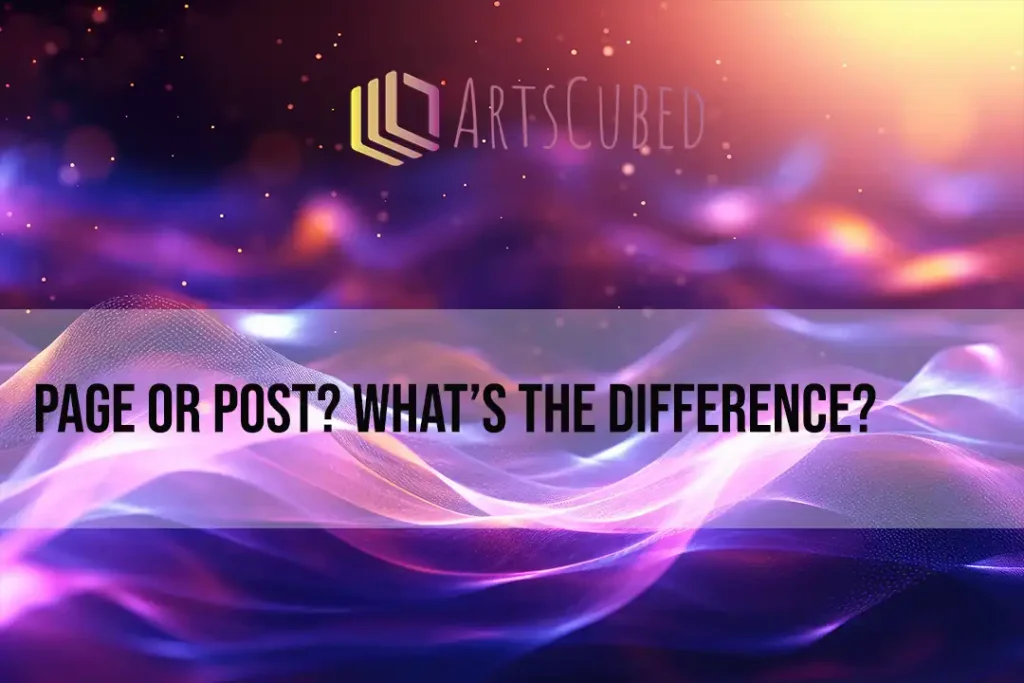
WordPress Pages vs. Posts: Choosing the Right Canvas for your content type
WordPress offers two main options for your content: Posts and Pages. Understanding the difference is key to organizing your website effectively, capitalizing on best practices in WordPress and also reducing expense if you are working with a professional designer. Pages and Posts have distinct functions within WordPress, but for those new to site building, the distinction can be confusing.
Choosing the right one ensures your content appears where it should and behaves as expected.
The Core Difference: Dynamic vs. Static Content
The simplest way to think about it is through the lens of time and relevance:
1. Posts are for dynamic and timely content
Posts are the core of a traditional blog. They are dynamic and timely—designed to be read, commented on, and eventually archived. Historically, WordPress only consisted of a single page and multiple posts, the ability to add additional pages came later. The characteristics of posts are:
- Timeliness: They are associated with a publication date that is often highly relevant
- Organization: They have the ability to be organized and displayed via categories, tags or date archives, enabling your site to serve up new content according to pre-defined organization and styling
- Display: displayed on one or more pages via a blog shortcode or post widget. The position of posts in the display will dynamically change as new post content is added.
- Interactivity: Can include a comment section and share buttons.
- Types of content usually made in a post: News Articles, Blog/Opinion Posts, Event Listings, Tutorials, Products.
Posts are how you keep your site fresh and engage with your audience regularly.
2. Pages: The Static, Evergreen Content
Pages are for static, evergreen content. They are the fixed points of your website’s structure and are not tied to a continuous, chronological flow. In some cases they have been professionally designed with elements such as sliders or video backgrounds or animated effects that are not easily editable by website beginners. The characteristics of WordPress pages are:
- Timeliness: Generally pages are not associated with a date.
- Organization: Pages are organized via WordPress’ menu function
- Display: Most pages will be linked from the sites main navigation and their position will be fixed.
- Interactivity: Commenting is generally disabled on pages, however pages can contain interactive elements such as forms and buttons.
- Examples of Common Pages: About, Content, Services, FAQ’s
Pages form the foundational structure of your site. One way we think about it at Arts Cubed is that pages are the gilded frames and galleries that are made to display your posts which are the art and jewels in the display cases.
A Practical Guide to Content Contribution
For many site owners, particularly those working with a professionally designed or business-oriented site, your content contribution strategy can be simplified:
Focus your efforts on Posts, Events and other Custom Post Types.
A well-designed website often features sophisticated, custom-built Pages that serve as the main landing points—the homepage, key product pages, or service descriptions. These Pages have typically been carefully structured by a designer to manage branding, conversion, and user experience.
If you are a contributor who is not the primary site architect or an experienced web designer, it is strongly recommended to use Posts for all new, dynamic content. Your site will be designed to have all the posts and custom post types you need to share your day to day content. This can include video and image portfolios and other special content that your site may be customized to display.
This approach allows you to:
- Maintain Site Integrity: By creating Posts, you contribute fresh content without accidentally disrupting the delicate structure, layout, or navigation of core Pages, which may be complex and use advanced features from builders like Elementor.
- Contribute Dynamically: Posts are perfect for news, updates, or upcoming events. Use the category and tag features to organize your topics. For example, if you are announcing an upcoming seminar, create a new Post titled “Seminar on Topic X – Date” and categorize it as “Events.”
- Leverage Automatic Feeds: New Posts will automatically populate on your site’s blog feed, ensuring your audience sees your latest information without you having to manually update navigation menus or static page content.
Leave the professionally designed Pages for the site’s fundamental, “set-it-and-forget-it” structure. If you need to create a new key navigational Page—for instance, a completely new product offering—it is best to consult with your site’s administrator or designer first.
If you have a site with 200 pages and 10 posts, (we’ve seen those!) you’ve gotten it backwards but all is not lost there are several plugins available that make it easy for you to convert pages to post and the reverse. We use The Post Type Switcher. Once you see the utility and affordances of sharing dynamic content, you’ll never make the same mistake again.
If you are unsure where to place your content, consider if it has a date that makes it temporary or archival. If the answer is yes, use a Post.






No comment yet, add your voice below!